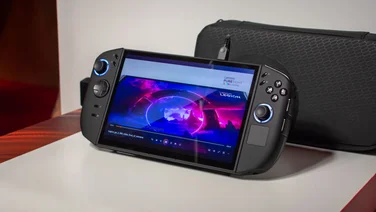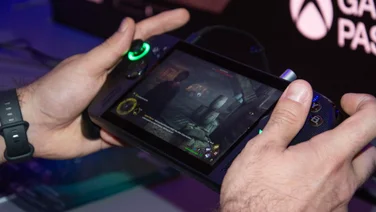To help us provide you with free impartial advice, we may earn a commission if you buy through links on our site. Learn more








- Excellent sound quality
- Stylish and comfortable
- Dual-audio streaming
- Expensive
- Lacklustre ANC
- No hard-shell case
The Bang & Olufsen Beoplay Portal is indicative of a seismic shift in the role that video games play in our culture. What was once dismissed as a pastime for basement-dwelling nerds has become the most lucrative global entertainment industry, and everybody wants a piece of the pie.
Bang & Olufsen first entered the arena in 2021 with the Beoplay Portal for Xbox, a premium gaming headset that doubles up as a pair of noise-cancelling Bluetooth headphones. A year on and PlayStation and PC owners have got an improved version, and it’s just as luxurious and expensive as you’d expect from a company with B&O’s pedigree.
Its price tag means only the most well-off gamers will be able to afford it, but those that can will be getting a comfortable, super-stylish headset that delivers top-notch sonic performance along with some very handy features.
Bang & Olufsen Beoplay Portal review: What do you get for the money?
The Beoplay Portal will set you back the princely sum of £449. That’s significantly more than top-of-range models from leading gaming brands such as Razer, HyperX, Astro and SteelSeries but this is Bang & Olufsen, so premium prices are to be expected.
The Portal is more than just a well-made gaming headset from an esteemed manufacturer, however. It functions as both a wireless gaming headset and Bluetooth headphones, and the incorporation of B&O’s trademarked “virtual boom arm” in place of an integrated microphone ensures it looks the part wherever you’re using it.
The Xbox version offered the ability to switch between Bluetooth and wireless sources, but the PC and PlayStation model allows gamers to stream audio from both simultaneously. This “dual-mode functionality” is an extremely useful addition and one that will likely leave those that bought the Xbox model feeling rather miffed.
Wireless connectivity to your PC or console is provided by a 2.4GHz USB-C dongle, while Bluetooth 5.1 handles the connection to your smartphone. There’s support for the standard SBC codec along with Apple’s AAC and Qualcomm’s aptX Adaptive, with the latter facilitating high-resolution streaming. Also supported are Dolby Atmos for Headphones (on PC), Google Fast Pair and Microsoft Swift Pair.
Noise cancellation is available for when you want to focus exclusively on what you’re playing, while a transparency mode enables you to hear your partner chastise you for playing Elden Ring all night.








The Beoplay Portal is compatible with the same B&O companion app as speakers such as the Beosound Explore and Beosound A1, and this provides access to battery life information, a number of listening modes (EQs) and personal settings such as whether you want the headset to turn off after 15 minutes of inactivity.
Battery life has received a decent boost from the Xbox model. When connected via Bluetooth and wireless with active noise cancellation on, you can expect somewhere in the region of 19 hours of use. If you’re just using Bluetooth and ANC, that figure jumps to 42 hours. In comparison, the Xbox model offers up to 12 hours and 24 hours in the same circumstances.
As well as the headset and wireless dongle, there’s a USB-A adapter included in the box, along with a USB-C cable for charging, a 3.5mm audio cable and a drawstring cloth carrying pouch.
READ NEXT: The best PC speakers
Bang & Olufsen Beoplay Portal review: What do we like?
The Beoplay Portal is, without doubt, the best-looking gaming headset I’ve used, and this is largely down to the fact it doesn’t really look like a gaming headset.
The frame is crafted from aluminium and plastic, while the outer surface of the headband and earcups are covered in leather. Soft fabric-coated padding runs along the inside of the headband and the earcups are filled with a spongy memory foam that’s forgiving on your ears. The overall aesthetic is clean and attractive, a far cry from the bulky, garish appearance of more generic gaming headsets.
Although the headband padding looks rather meagre, the Portal is supremely comfortable. It’s pleasingly lightweight at just 279g and never feels cumbersome on your head, even as you approach hour six of a marathon gaming session. Just the right amount of clamp force is applied on your head, and the circular earcups provide a snug fit while leaving enough space for your ears to breathe.








Controls can be found on both earcups and are very effectively implemented. The left earcup houses a Bluetooth pairing button and a touch control slider that lets you move between maximum active noise cancellation and maximum transparency, which pipes in external sound.
The layout is identical on the right earcup, but here the slider controls in-game volume and the button powers the headset on and off. You can also use double taps on the outside of each cup to execute specific commands, which can be assigned in the B&O app. Just below the power button, you’ll find an AUX-in and a USB-C charging port. You probably won’t find yourself using the analogue connection very often but it’s welcome nonetheless.
I touched on how handy the dual audio streaming is above, but it’s probably my favourite of the Beoplay Portal’s features. Being able to listen to a podcast while grinding for a rare drop or discussing strategy with mates on Discord as you face a raid boss feels wonderful.
You’ll need your smartphone close by to change the volume of whatever audio’s being streamed via Bluetooth, but the chances are you’re going to have it to hand anyway. Thoughtful touches, such as the ability to mute gaming sound automatically if you receive a call or ignore calls entirely when gaming, indicate that B&O has carefully considered the user experience, and it should be applauded for that.
It also deserves a lot of praise for the sound generated by the Portal’s 40mm drivers. Audio quality is an area you’d expect a company with B&O’s reputation to excel in and it doesn’t disappoint. The Portal avoids the trap of going all-in on an overwhelming low-end response and instead delivers well-balanced sound across the frequency spectrum. Gunshots and explosions have plenty of weight behind them, but bass doesn’t dominate proceedings as it does with so many other gaming headsets.








The detail on offer is highly impressive, too. Exploring the Lands Between in Elden Ring, I was able to pick out the smallest of audio cues in my surroundings. Whether it was a giant rat skulking in the shadows or an NPC chuntering away in an abandoned shack, the Portal highlighted everything that was going on around me marvellously.
There’s reasonable width to the Portal’s soundstage and this enables it to take advantage of the PlayStation’s Tempest engine 3D audio. Sounds were positioned accurately, leading to a great sense of immersion in the in-game worlds I frequented during testing. On PC, the Portal benefits considerably from support for the Dolby Atmos spatial audio format, though height effects aren’t quite as convincing as they could be.
The Portal delivers an equally enjoyable experience while listening to music. Again, audio is characterised by a sensible balance between bass, mids and treble, with no aspect overplaying its hand. Lower frequencies possess a pleasingly rich rumble, mids are crystal clear and there’s an openness in the upper registers.
Should you wish to change how the Portal headset sounds, there’s a wide range of listening modes (EQs) available in the B&O app that differ slightly depending on whether you’re connected wirelessly or via Bluetooth. When gaming over the wireless connection, you get a couple of genre-specific options – FPS and RPG – in addition to Gaming, Music and Movie modes, all of which can be tweaked using a five-band graphic equaliser. If you’re using a Bluetooth connection, you’re presented with Optimal, Commute, Podcast, Movie and Gaming options.
READ NEXT: The best TVs for gaming
Bang & Olufsen Beoplay Portal review: What could be improved?
While I love that the Beoplay Portal does away with a detachable or integrated arm microphone, there’s room for improvement with its “virtual boom arm”.
The beamforming technology behind it is very clever, with four mics built into the headset using digital signal processing to pinpoint and isolate your voice before articulating it. Reports about how I sounded were generally positive – I was always intelligible – but friends commented that they occasionally picked up on some echoing and a bit of background noise.
I feel this is a sacrifice worth making to achieve an aesthetic that looks great both at home and further afield, but it might make those that plan on doing a lot of recording or streaming think twice.








The active noise cancellation on offer also falls short of the standards set by premium ANC headphones. It works well enough if you’re at home but in noisier environments, there’s a clear discrepancy between the attenuation on offer from the Portal and options such as the Bose QC 45 or Sony WH-1000XM4. That’s to be expected given ANC is the headline feature of those class-leading headphones, but it does leave the Portal’s noise cancellation feeling like a bit of an afterthought.
Finally, I feel Bang & Olufsen should have included a hard-shell carrying case with the Portal rather than a cloth bag. This is a very expensive headset that B&O wants you to use outside the confines of your games room and, as such, you need a way to keep it safe in transit. The cloth bag is of reasonable quality but doesn’t afford the same level of protection you’d get from a sturdy case, the likes of which similarly priced headphones almost always come with.
Bang & Olufsen Beoplay Portal review: Should you buy it?
As you might have gathered, I’m rather taken by the Beoplay Portal. It fulfils its dual roles as a gaming headset and Bluetooth headphones brilliantly while looking and feeling every inch the premium product it is.
It’s not perfect – both the virtual boom arm and noise cancellation could be better – but in terms of comfort and sound quality, it’s hard to beat. Add to that dual-audio streaming capability and a sprinkling of customisation options and you’ve got yourself a force to be reckoned with.
There is one caveat: it’s only worth buying if you don’t already own a pair of decent over-ear noise-cancellers. I spend a significant proportion of my spare time gaming but wouldn’t pay £449 for the Portal solely for use while playing games. However, if it’s going to become your go-to for gaming, commuting and casual listening, which it’s more than capable of doing, the outlay is easier to justify for dedicated gamers and music lovers.








